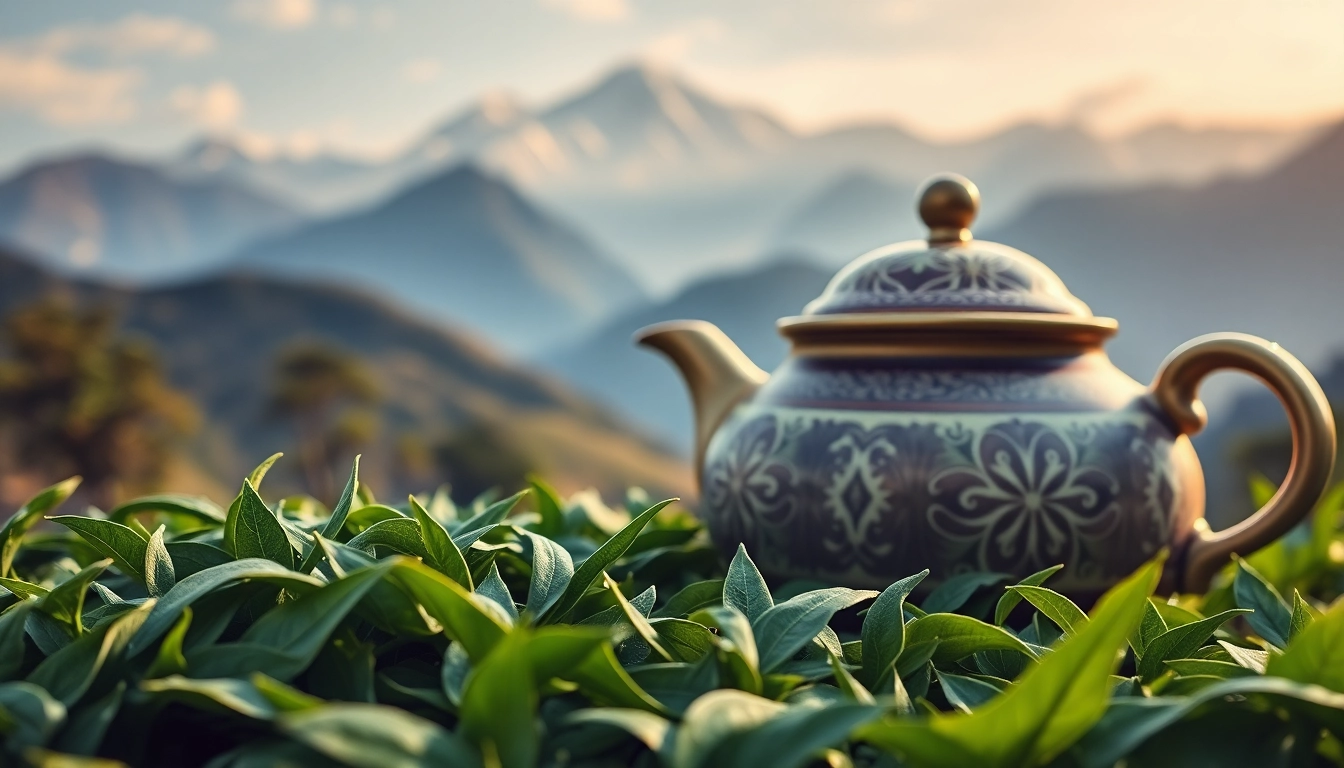The Unique Characteristics of Nepal Tea
Nepal tea is emerging as a favorite among tea aficionados worldwide. Grown in the high-altitude regions of mountainous Nepal, these teas boast distinctive characteristics that set them apart from more commonly known varieties, such as Darjeeling. The unique blend of climate, soil, and cultivation practices contribute to the vibrant character and unparalleled freshness of Nepal tea, making it a remarkable experience for anything from casual sippers to serious connoisseurs.
Flavor Profiles of Different Nepal Tea Varieties
Nepal offers a rich diversity of tea varieties, each with its unique flavor profile. Among the most popular are:
- Black Tea: Typically robust with a rich, malty flavor, Nepalese black teas often carry floral notes, bringing complexity to the palate. Notable varieties include the Ilam black tea, which offers a smooth finish with hints of caramel.
- Green Tea: The green teas from Nepal, such as the Himalayan green tea, showcase grassy undertones with a refreshing, crisp taste. They are handpicked and minimally processed to retain their natural flavors.
- White Tea: Known for its delicate flavor, Nepalese white tea is crafted from the young leaves and buds, resulting in a subtle, sweet profile that is perfect for those who appreciate a milder tea.
- Herbal Teas: Unique blends utilizing local herbs and spices create a flavorful assortment of herbal teas that can cater to various tastes and health benefits.
Health Benefits Associated with Drinking Nepal Tea
Beyond flavor, Nepal tea presents numerous health benefits. Rich in antioxidants, these teas can help combat oxidative stress and inflammation. Some of the key health benefits include:
- Improved Digestion: Herbal teas, particularly those containing ginger or mint, can aid digestive processes and enhance gut health.
- Heart Health: The polyphenols found in black and green teas may support cardiovascular health by improving blood circulation and lowering blood pressure.
- Boosting Immune Function: Antioxidant-rich teas can bolster the immune system, making it easier to fend off colds and infections.
- Enhanced Mental Clarity: Some studies indicate that the caffeine and L-theanine combination in black and green teas can improve focus and reduce fatigue.
Comparative Analysis: Nepal Tea vs. Other Teas
When comparing Nepal tea to popular varieties like Darjeeling or Assam, several differences emerge:
- Altitude and Terroir: Nepal’s high-altitude plantation regions lead to slower growth, which allows for the development of deeper flavors in the tea leaves. This is less common in many other tea-producing regions.
- Processing Techniques: Nepalese tea producers often utilize traditional methods, resulting in organic and environmentally-friendly teas that stand out against mass-produced counterparts.
- Flavor Complexity: Many Nepal teas exhibit complex flavor notes and a smoother finish compared to the sometimes astringent qualities of teas from India and China…
The Cultivation Process of Nepal Tea
The cultivation of Nepal tea is a meticulous process influenced by the region’s unique climate and geography. From planting to harvesting, several steps need to be carefully followed to ensure the highest quality:
High-Altitude Farming: What Makes It Special?
High-altitude farming is beneficial for tea cultivation due to several factors:
- The cooler temperatures slow down the growth of tea plants, allowing for more flavor development.
- Increased sunlight exposure at higher elevations enhances photosynthesis, leading to more vibrant tea flavors.
- The mineral-rich soil found in the Himalayan foothills imparts unique qualities to the tea, making it distinctive from teas grown at lower altitudes.
Organic Practices in Nepal Tea Production
Organic farming practices are prevalent in Nepal’s tea industry, as many producers focus on sustainability:
- Minimal use of synthetic fertilizers and pesticides helps in preserving the environment and enhancing the natural taste of the teas.
- Many tea estates in Nepal are certified organic, ensuring adherence to strict agricultural standards.
- Soil and water conservation techniques are implemented, promoting healthy ecosystems and biodiverse farming systems.
Harvesting Techniques and Their Impact on Quality
The harvesting process plays a crucial role in determining the quality of the tea. In Nepal, hand-picking is often employed, which allows for several advantages:
- Only the finest leaves are selected, ensuring a high-quality output.
- Hand-picking reduces damage to the plants and encourages better growth in subsequent seasons.
Brewing the Perfect Cup of Nepal Tea
Once you’ve selected your favorite Nepalese tea, the next step is brewing it correctly to maximize flavor and health benefits. Here’s how you can achieve that:
Essential Tools and Equipment for Tea Preparation
To brew a fine cup of Nepal tea, consider having the following tools on hand:
- Teapot or Gaiwan: Both are suitable vessels for steeping tea, allowing for the release of flavors.
- Tea Infuser or Strainer: To keep loose leaves from floating in your cup.
- Thermometer: Ensuring your water is the right temperature for different tea types is essential for optimal flavor extraction.
- Timer: Over-steeping can lead to bitterness. A timer will help achieve the perfect brew.
Step-by-Step Brewing Instructions
Black Tea
- Bring water to a boil at 200-212°F (93-100°C).
- Add 1 teaspoon of loose-leaf black tea per cup.
- Steep for 3-5 minutes depending on the desired strength.
Green Tea
- Heat water to about 175-185°F (80-85°C).
- Use 1 teaspoon of loose-leaf green tea per cup.
- Steep for 2-3 minutes to extract flavor.
White Tea
- Bring water to 160-180°F (71-82°C).
- Measure out 1-2 teaspoons of tea leaves per cup.
- Allow to steep for 4-5 minutes.
Tasting Notes: How to Appreciate Nepal Tea
When savoring Nepal tea, consider the following:
- Aroma: Take a moment to inhale the tea’s aroma before tasting. This will elevate your sensory experience.
- Flavor: Sip slowly, noting the initial taste and how it develops on your palate.
- Finish: Pay attention to the aftertaste. A good Nepal tea often leaves a lingering pleasant flavor.
Where to Buy Quality Nepal Tea
With the rising popularity of Nepal tea, many options are available for purchasing authentic products, ensuring that enthusiasts can access the finest selections:
Online Retailers Offering Authentic Nepal Tea
Many reputable online platforms feature a variety of Nepal tea. Look for retailers that specialize in organic and single-origin teas to ensure you are getting a quality product. Some online shops provide tasting notes and descriptions that help you narrow down your options.
Local Shops and Cafes Featuring Nepal Tea
If you prefer to purchase locally, many tea shops and cafes now offer Nepalese varieties. Visiting these venues allows you to speak with knowledgeable staff and often sample teas before buying.
Ethical Sourcing: Supporting Nepalese Farmers
When you choose to buy Nepal tea, look for brands that emphasize fair trade practices. Supporting ethical sourcing not only helps local communities thrive but also ensures that you’re choosing an environmentally sustainable product.
Enhancing Your Experience with Nepal Tea
Beyond merely drinking Nepal tea, various practices can enhance your experience and appreciation of this exquisite beverage:
Pairing Nepal Tea with Food for Maximum Flavor
Understanding how to pair your tea with food can elevate both components. Here are some suggestions:
- Black Tea: Pair with rich desserts like chocolate cakes or spiced pastries.
- Green Tea: Works well with light dishes such as sushi or fresh salads.
- Herbal Teas: Complement meals featuring aromatic spices, enhancing the overall dining experience.
Tea Ceremonies: Traditions from the Kathmandu Valley
Engaging in a tea ceremony provides insight into the cultural significance of tea in Nepal. These ceremonies often emphasize hospitality and mindfulness, allowing participants to connect more deeply with each cup.
Innovative Recipes Using Nepal Tea
Experimenting with Nepal tea in culinary creations can yield delicious rewards:
- Tea Infused Rice: Use brewed tea to cook rice, imparting flavor and aroma.
- Tea Smoothies: Blend cooled tea with fruits for a refreshing drink.
- Tea Ice Cream: Infuse cream with brewed tea to create unique dessert options.














Leave a Reply